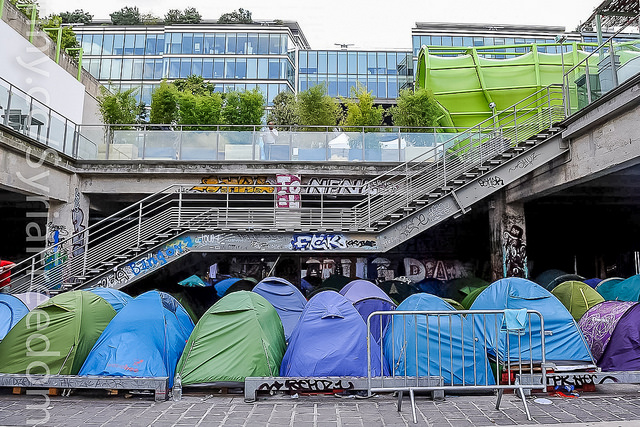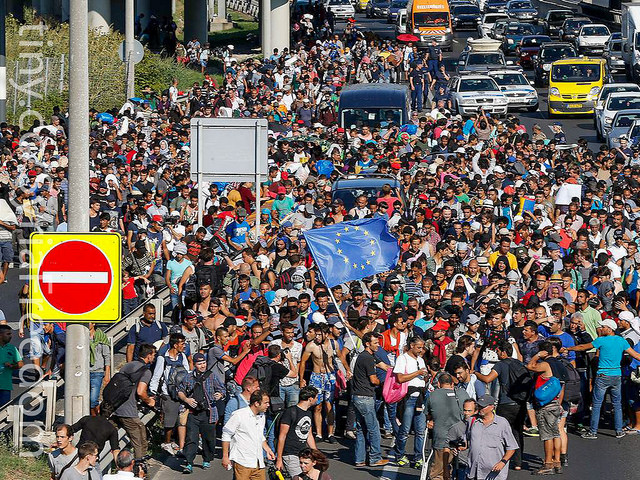
Photo courtesy of Freedom House
The economic impact is likely to be slightly positive in the short-term. All the refugees arriving in the European Union need to be housed and fed. Their medical needs must be addressed, and both children and adults have to be educated in preparation for entry into local labor markets. Before they are ready to work, financial support is also necessary. The ensuing boost to government spending and fiscal transfers will give domestic demand a shot in the arm. According to estimates from the IMF, by the end of 2017 GDP in Austria, Germany and Sweden—three countries which have received large numbers of refugees per capita—will have been boosted by 0.5%, 0.3% and 0.4%, respectively. In Germany, by far the largest recipient in absolute terms, refugee-related expenditure amounted to more than EUR 20 billion last year.
In the longer term, the picture becomes far murkier. This isn’t just because little is known about the current cohort of refugees, such as their average level of education or how long they will remain in their host countries. It is also because the long-term economic impact of refugees rests largely on how successful countries are at weaving them into the economic fabric of their societies. The more refugees who find jobs, and the better paid these jobs are, the greater the positive impact on labor supply, the public coffers and economic growth.
Upon arrival, however, asylum seekers face myriad problems which hinder their integration into the labor market. Many find that the qualifications they held in their home countries are no longer recognized, and even those who hold valid qualifications are faced with a language barrier; the vast majority of the refugees who have reached the European Union in the last few years lack basic competence in their host country’s language. The process of applying for and being granted asylum is also a protracted one, often lasting around six months. In some European nations, it is even longer, as the sudden influx of refugees has led to a huge backlog of unprocessed claims. In many countries, asylum seekers are not normally allowed to work while their claims are being processed, increasing the risks of demotivation and deskilling. Even in Germany, which is known for the efficiency of its bureaucracy and labor market, only around 500,000 of the 1.2 million refugees had completed the first stages of the integration process and signed up as job seekers by March 2017. Of these refugees, a mere 12% had found employment.

Photo courtesy of Freedom House
If past experience is anything to go by, the full economic integration of refugees will prove an arduous task. Studies from many developed countries have repeatedly shown that refugees tend to earn less, have worse employment prospects and hold lower occupational status than native workers or economic migrants. Even in Sweden, a country with a relatively strong track record of integrating refugees, a study of those arriving between 1997 and 2010 found that fewer than 20% had found employment after one year. Ten years down the line, only between 50% and 60% were working, significantly below the corresponding figure for Swedish natives.
However, there is much that nations can do to help refugees integrate more seamlessly into society. For instance, Germany’s integration law, which was approved by its parliament in 2016, provides culture and languages classes for newcomers. This policy is similar to Sweden’s longer-standing introduction program, which includes an interview with the Public Employment Service (PES) in order to create a tailored action plan for each refugee, and provides personalized training, employment assistance, and financial and housing support. Special measures in the labor market could also be considered, in order to overcome any initial jitters employers may have about hiring refugees. Wage subsidies for firms who hire refugees have proven effective in several Nordic countries. The experience of refugees in the Netherlands has shown that work at temporary agencies can be another useful stepping stone, helping new arrivals adjust to labor market conditions. Enabling asylum seekers to hit the ground running and apply for jobs upon arrival, provided certain conditions are met, would also help; this is currently the case in Sweden, for example.
Policies which boost the labor market participation rate more generally will likely have an outsized effect on refugees. Improving the geographical mobility of migrants, making labor markets suppler and thus more adaptable to tumultuous technological change, and avoiding welfare traps due to an overlap between the benefit system and the tax system would all help refugees get their foot on the employment ladder.

Photo courtesy of Freedom House
While the successful integration of refugees poses a challenge to policymakers, it could pay dividends in the long term. Europe is ageing fast, with the old-age dependency ratio in the EU-28 forecast to soar from 28.8% in 2015 to 50.3% by the middle of the century. Many pension and healthcare systems across the continent are already creaking under the strain of having to provide for so many retirees. The most recent wave of refugees arriving in Europe could help alleviate this burden to an extent. Most refugees are young: Around 50% of those who have sought asylum in the EU over the last few years are between 18 and 34, while nearly one-third are younger than 18. They are also likely to have higher fertility rates than native-born citizens. Both of these factors should help slow the rate of ageing and lessen the impact of the transition of our greying societies. The IMF estimates that the current influx of refugees could reduce pension spending by 0.25 percentage points of GDP by 2030 for the EU as a whole, and by more for large recipient countries.
Whatever the net impact of refugees on the macroeconomy, this question is far from being at the forefront of people’s minds. Instead, most people are much more preoccupied with how refugees could affect their daily lives, and whether they will have to compete with them directly for jobs. This fear helps partially explain the recent rise in popularity of far-right parties, such as the Swedish Democrats in Sweden, or the AfD party in Germany. On this issue, concerns are only partly justified. Research has shown that displacement effects can exist, and domestic workers with similar skillsets to newcomers are more likely to lose out, while other types of workers gain. However, the time horizon, state of the economy and the flexibility of labor markets are all key factors, and these effects are rarely felt in the long run in growing economies where workers can move smoothly between jobs.
Over four years after he arrived, Avindar has integrated well into Danish society. He is training to become an IT technician, and in the meantime works part-time at a local supermarket to help pay the bills. He has learned the local language, has a close group of Danish friends, and pays taxes. Avindar is, in short, one of the lucky ones. He is young, and his family was wealthy enough to travel directly to Denmark, rather than embark on a perilous journey across the continent. The Danish economy is also fortunate to have him. By learning a trade, working and paying taxes, Avindar is making a positive contribution to his host country. The economic impact of many others may be less clear-cut. But the experience of people like Avindar shows that, with a well-functioning labor market and the right public policies in place, it is possible for refugees to become integrated into both society and the economy.